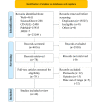Facilitators and Barriers to the Adoption of Telemedicine During the First Year of COVID-19: Systematic Review
- PMID: 34854815
- PMCID: PMC8729874
- DOI: 10.2196/31752
Facilitators and Barriers to the Adoption of Telemedicine During the First Year of COVID-19: Systematic Review
Abstract
Background: The virulent and unpredictable nature of COVID-19 combined with a change in reimbursement mechanisms both forced and enabled the rapid adoption of telemedicine around the world. Thus, it is important to now assess the effects of this rapid adoption and to determine whether the barriers to such adoption are the same today as they were under prepandemic conditions.
Objective: The objective of this systematic literature review was to examine the research literature published during the COVID-19 pandemic to identify facilitators, barriers, and associated medical outcomes as a result of adopting telemedicine, and to determine if changes have occurred in the industry during this time.
Methods: The systematic review was performed in accordance with the Kruse protocol and the results are reported in accordance with the PRISMA (Preferred Reporting Items for Systematic Reviews and Meta-Analyses) guidelines. We analyzed 46 research articles from five continents published during the first year of the COVID-19 pandemic that were retrieved from searches in four research databases: PubMed (MEDLINE), CINAHL, Science Direct, and Web of Science.
Results: Reviewers identified 25 facilitator themes and observations, 12 barrier themes and observations, and 14 results (compared to a control group) themes and observations. Overall, 22% of the articles analyzed reported strong satisfaction or satisfaction (zero reported a decline in satisfaction), 27% reported an improvement in administrative or efficiency results (as compared with a control group), 14% reported no statistically significant difference from the control group, and 40% and 10% reported an improvement or no statistically significant difference in medical outcomes using the telemedicine modality over the control group, respectively.
Conclusions: The pandemic encouraged rapid adoption of telemedicine, which also encouraged practices to adopt the modality regardless of the challenges identified in previous research. Several barriers remain for health policymakers to address; however, health care administrators can feel confident in the modality as the evidence largely shows that it is safe, effective, and widely accepted.
Keywords: COVID-19; digital health; health care; health policy; pandemic; technology acceptance; telehealth; telemedicine.
©Clemens Kruse, Katharine Heinemann. Originally published in the Journal of Medical Internet Research (https://www.jmir.org), 04.01.2022.
Conflict of interest statement
Conflicts of Interest: None declared.
Figures
Similar articles
-
Signs and symptoms to determine if a patient presenting in primary care or hospital outpatient settings has COVID-19.Cochrane Database Syst Rev. 2022 May 20;5(5):CD013665. doi: 10.1002/14651858.CD013665.pub3. Cochrane Database Syst Rev. 2022. PMID: 35593186 Free PMC article.
-
Measures implemented in the school setting to contain the COVID-19 pandemic.Cochrane Database Syst Rev. 2022 Jan 17;1(1):CD015029. doi: 10.1002/14651858.CD015029. Cochrane Database Syst Rev. 2022. Update in: Cochrane Database Syst Rev. 2024 May 2;5:CD015029. doi: 10.1002/14651858.CD015029.pub2. PMID: 35037252 Free PMC article. Updated.
-
Facilitators of and Barriers to Accessing Hospital Medical Specialty Telemedicine Consultations During the COVID-19 Pandemic: Systematic Review.J Med Internet Res. 2023 Jul 10;25:e44188. doi: 10.2196/44188. J Med Internet Res. 2023. PMID: 37262124 Free PMC article.
-
Factors Influencing the Acceptance and Adoption of Mobile Health Apps by Physicians During the COVID-19 Pandemic: Systematic Review.JMIR Mhealth Uhealth. 2023 Nov 8;11:e50419. doi: 10.2196/50419. JMIR Mhealth Uhealth. 2023. PMID: 37938873 Free PMC article.
-
A rapid and systematic review of the clinical effectiveness and cost-effectiveness of topotecan for ovarian cancer.Health Technol Assess. 2001;5(28):1-110. doi: 10.3310/hta5280. Health Technol Assess. 2001. PMID: 11701100
Cited by
-
Interventions to reduce social isolation and food insecurity in older adults: a systematic review.Front Nutr. 2025 Jun 6;12:1607057. doi: 10.3389/fnut.2025.1607057. eCollection 2025. Front Nutr. 2025. PMID: 40547373 Free PMC article.
-
Leveraging mHealth and Virtual Reality to Improve Cognition for Alzheimer's Patients: A Systematic Review.Healthcare (Basel). 2022 Sep 23;10(10):1845. doi: 10.3390/healthcare10101845. Healthcare (Basel). 2022. PMID: 36292292 Free PMC article. Review.
-
Stakeholders' Initial Experience With Telemedicine Services Introduced at 13 Government Medical Colleges in Uttar Pradesh, India During the COVID-19 Lockdown: A Qualitative Study.Cureus. 2023 Jul 2;15(7):e41269. doi: 10.7759/cureus.41269. eCollection 2023 Jul. Cureus. 2023. PMID: 37533613 Free PMC article.
-
Barriers and shortcomings in access to cardiovascular management and prevention for familial hypercholesterolemia during the COVID-19 pandemic.Clin Cardiol. 2023 Aug;46(8):831-844. doi: 10.1002/clc.24059. Epub 2023 Jun 1. Clin Cardiol. 2023. PMID: 37260143 Free PMC article. Review.
-
Mapping Inequities in Digital Health Technology Within the World Health Organization's European Region Using PROGRESS PLUS: Scoping Review.J Med Internet Res. 2023 Apr 28;25:e44181. doi: 10.2196/44181. J Med Internet Res. 2023. PMID: 37115613 Free PMC article.
References
-
- World Health Organization . Telemedicine: opportunities and developments in member states: report on the second global survey on eHealth 2009. Geneva, Swizerland: World Health Organization; 2010.
-
- FitzGerald M, Williams R. Commonwealth Fund. 2020. Nov 20, [2021-02-15]. https://www.commonwealthfund.org/blog/2020/variations-telemedicine-acros... .
-
- Bokolo AJ. Exploring the adoption of telemedicine and virtual software for care of outpatients during and after COVID-19 pandemic. Ir J Med Sci. 2021 Feb;190(1):1–10. doi: 10.1007/s11845-020-02299-z. http://europepmc.org/abstract/MED/32642981 10.1007/s11845-020-02299-z - DOI - PMC - PubMed
-
- Fieux M, Duret S, Bawazeer N, Denoix L, Zaouche S, Tringali S. Telemedicine for ENT: Effect on quality of care during Covid-19 pandemic. Eur Ann Otorhinolaryngol Head Neck Dis. 2020 Sep;137(4):257–261. doi: 10.1016/j.anorl.2020.06.014. https://linkinghub.elsevier.com/retrieve/pii/S1879-7296(20)30153-8 S1879-7296(20)30153-8 - DOI - PMC - PubMed
Publication types
MeSH terms
LinkOut - more resources
Full Text Sources
Medical


